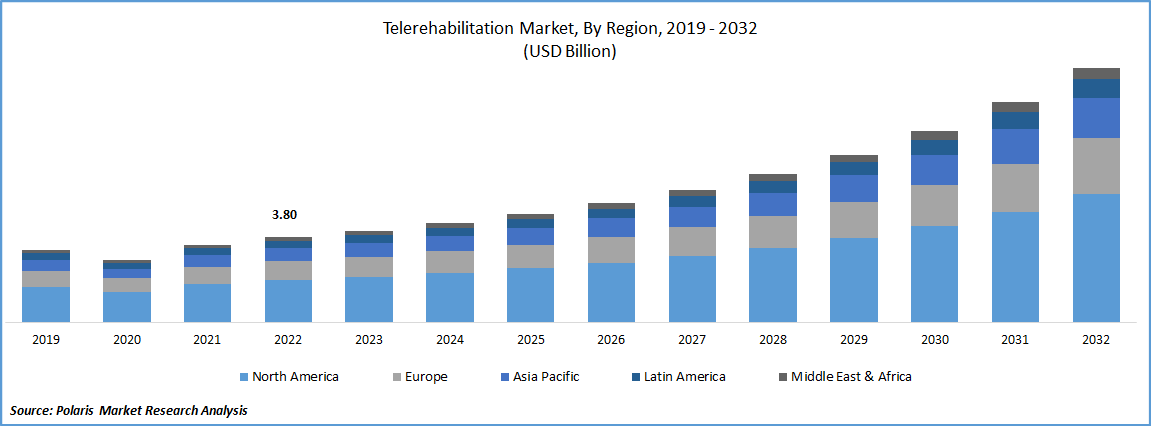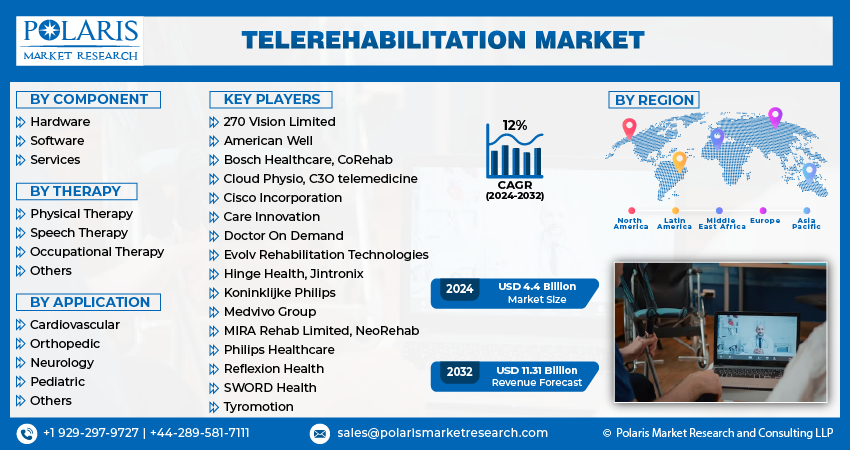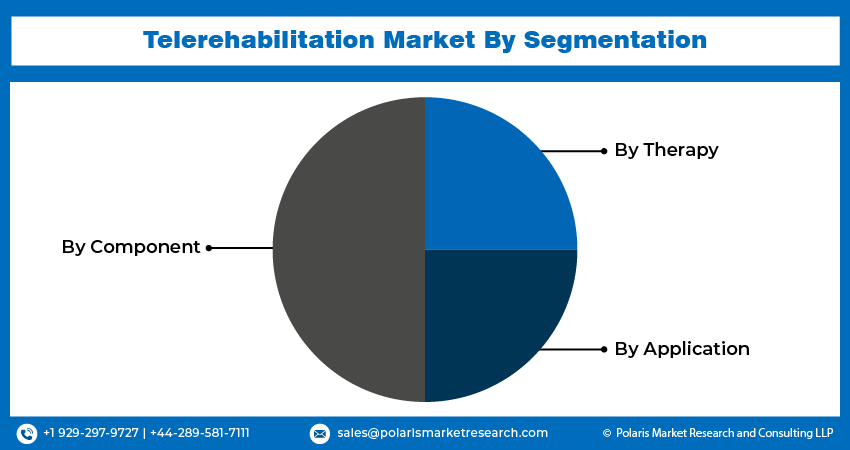
Telerehabilitation Market Share, Size, Trends, Industry Analysis Report
By Component (Hardware, Software, and Services); By Therapy; By Application; By Region; Segment Forecast, 2024- 2032
- Published Date:Jan-2024
- Pages: 118
- Format: PDF
- Report ID: PM3394
- Base Year: 2023
- Historical Data: 2019-2022
Report Outlook
The global telerehabilitation market was valued at USD 4.07 billion in 2023 and is expected to grow at a CAGR of 12% during the forecast period. Technological advancements, increasing prevalence of chronic diseases, rising need for remote patient monitoring options, and rising need for cost-effective solutions are prime factors responsible for market growth. The delivery of rehabilitation services over a telecommunications network and the internet is referred to as telerehabilitation, sometimes known as e-rehabilitation. Telehealth solutions have been shown to improve health outcomes while also lowering expenses. When compared to traditional approaches, telerehabilitation saves money for patients, providers, and payers.

To Understand More About this Research: Request a Free Sample Report
Through the use of telerehabilitation services, medical experts can diagnose patients and deliver therapy from a distance. The medical specialties of physical therapy, speech-language pathology, occupational therapy, audiology, and psychology are a few of those that are using telerehabilitation. Among the many therapeutic methods are workouts for the motor system, speech and language therapy, robotic treatment, virtual environments, goal-setting, and team sports.
Telerehabilitation is the use of information and communication technology to provide rehabilitation treatments remotely. The therapeutic effectiveness and safety of telerehabilitation, as well as its capacity to increase utilization and access to rehabilitation treatments for persons with chronic respiratory diseases, have not yet been thoroughly evaluated. It has lowered healthcare costs while boosting efficiency, through better chronic illness management, shorter travel times, pooled health professional staffing, and fewer and shorter hospital stays. As a result of all of the aforementioned factors, the market is predicted to grow rapidly over the projected period.
The demand for telerehabilitation is also being driven by the increase in osteoarthritis patients. One of the main causes of disability in the US is osteoarthritis. As per the National Academy of Science, Knee OA affects at least 19% of American people aged 45 and older, and knee OA causes more than 80% of the disease's overall burden. When compared to clinic-based treatment, OA and telerehabilitation have been found to produce larger improvements in quality of life.
The global market has seen strong growth during the COVID-19 pandemic as several countries across the globe have experienced a high demand for telehealth due to the pandemic. As long as social distancing standards are to be followed, digital health and telerehabilitation technologies continue growing in popularity. Several COVID-19 protocols require people to stay indoors and avoid congestion. Several companies have seen a positive impact on market growth. During the COVID-19 epidemic, this had a favorable impact on the market. However, as increased access to basic healthcare along with improved healthcare quality and improved safety has been seen, the need for telemedicine is expected to rise significantly. COVID-19 is projected to have a positive impact on the market due to the benefits of teler-ehabilitation.

Industry Dynamics
Growth Drivers
The increasing healthcare cost is the factor driving the telerehabilitation market growth. Globally, healthcare costs are rising as much more people use healthcare services, increasing demand for novel and creative procedures as well as lifestyle issues. It can also be attributed to cost-shifting from public programs to private payers, which has resulted in higher costs for hospitals and physicians, who then charge private payers far higher prices for the same services due to poor reimbursement rates. The market is anticipated to have a considerable increase in potential throughout the forecast period due to a lack of access to care, higher provider acceptance of telemedicine, increased consumer demand and patient acceptability, and better treatment quality.
Additionally, it is anticipated that the market will be driven by the expanding acceptance of digital technologies in the healthcare sector as well as the global expansion of smartphones and the internet. Also, both governmental and private entities carry out a variety of programs. The central government has announced a program to help people with disabilities buy or lift goods and devices (ADIP). The main goal of the Scheme is to help needy disabled people acquire long-lasting, high-tech, modern, standard aids and appliances that are produced using science. These aids and appliances can promote their own physical, social, and psychological rehabilitation by lessening the consequences of disabilities and "enhancing their economic potential." These programs are credited with raising consumer awareness of telerehabilitation services, which is anticipated to spur industry expansion.
Report Segmentation
The market is primarily segmented based on component, therapy, application, and region.
|
By Component |
By Therapy |
By Application |
By Region |
|
|
|
|
To Understand the Scope of this Report: Speak to Analyst
Occupational therapy segment is expected to witness the fastest growth during forecast period
Occupational therapy aids people with physical, mental, and sensory issues in regaining their independence in all facets of everyday living. Throughout the projection period, it is anticipated that an increase in the number of people with various conditions, such as dementia, Alzheimer's disease, amputations, etc., will fuel demand for these software solutions. As per to the Alzheimer's Association, around 6 million people have Alzheimer's disease across the globe. This data is expected to reach around 13 million by 2050. Alzheimer's disease and other dementias will cost the country USD 345 billion in 2023. These expenses might reach about USD 1 trillion, by 2050.
Further, Alzheimer's disease or similar dementia causes 1 in 3 elderly deaths. More than 11 million Americans give unpaid care to those who have dementia or other forms of Alzheimer's disease. Aside from that, occupational therapists are utilizing electronic information and communication technology to provide treatment to clients remotely. This is anticipated to accelerate segment growth. Moreover, telephysiotherapy treatments can regulate physiological signals including pulse rate, oxygen levels, electrocardiograms (ECG), and joint motion frequency in some communities, such as people with cardiorespiratory illnesses or orthopedic problems. This convenience is predicted to cause the segment to expand throughout the projection period.
Hardware accounted for the second-largest market share in 2022
The hardware segment is inclusive of medical peripheral devices, webcams, speakers, microphones, display screens, videoconferencing devices, laptops, and monitors. This is growing due to the rising demand for monitors, as to communicate with any professional, the need for having hardware is very important. Apart from it, the presence of major key players in the manufacturing of telemedicine devices and kits, and the availability of telemedicine at low cost are propelling the growth of the segment during the forecast period.
The support given to healthcare systems has resulted in a marked increase in the usage of diverse software. The increasing need for patient care cost reduction, the growing requirement for accurate and timely information acquisition, and the quickly rising medical costs are driving its adoption. Market participants are creating software apps to aid doctors in diagnosing and treating patients more quickly. For instance, in April 2018, TheraNow, a brand-new offering from Therainc, is an online platform that uses teletherapy to link patients with physical therapists. To offer rehabilitation services to distant communities, Such an effort is anticipated to fuel segment growth during the projection period.

The demand in North America is expected to witness significant growth druing forecast period
North America is expected to dominate the market due to the rise in the adoption of telerehabilitation solutions during the COVID-19 pandemic. The availability of superior healthcare facilities with ample budgets dedicated to emergency care delivery to prevent disease spread is contributing to the market's expansion in the region. The drivers of market expansion are the availability of cutting-edge healthcare technologies and a rise in e-visits. It will benefit consumers by facilitating the growth of telehealth technologies in the area and enhancing access to healthcare services.
Also, the market expansion is being fueled by the increased prevalence of chronic illnesses and an advanced healthcare system. The market is growing as a result of technological developments in rehabilitation and growing public awareness of remote patient monitoring. The growth is mainly attributed due to the rapidly aging population that leads to the popularity of homecare patient settings and technological advancements in healthcare infrastructures. Apart from it, the rising healthcare investments and government initiatives in the region, are the factors driving the growth of the market.
Asia-Pacific is anticipated to exhibit the fastest growth in the market. This is due to the increasing population, increasing government spending, rising patient awareness, and rising disposable incomes. For instance, it is estimated by the World Economic Forum that by 2030, the region will roughly contribute 60% to global growth. Apart from it, according to the United Nations Population Fund, it is home to 60% of the global population, which is around 4.3 Bn people, including China & India.

Competitive Insight
Some of the major players operating in the global telerehabilitation market include 270 Vision Limited, American Well, Bosch Healthcare, CoRehab, Cloud Physio, C3O telemedicine, Cisco Incorporation, Care Innovation, Doctor On Demand, Evolv Rehabilitation Technologies, Hinge Health, Jintronix, Koninklijke Philips, Medvivo Group, MIRA Rehab Limited, NeoRehab, Philips Healthcare, Reflexion Health, , SWORD Health, & Tyromotion.
Recent Developments
- In November 2022, Sensoria Health unveiled the wearable telerehabilitation platform. The wearable telerehabilitation platform has been unveiled by Sensoria Health. It is simple and effective for physical therapists and practitioners to remotely monitor the most prevalent conditions in their patient population with Sensoria's patient-centric, multi-device mobile and cloud program tele-rehab solution.
Telerehabilitation Market Report Scope
|
Report Attributes |
Details |
|
Market size value in 2024 |
USD 4.4 billion |
|
Revenue Forecast in 2032 |
USD 11.31 billion |
|
CAGR |
12% from 2024- 2032 |
|
Base year |
2023 |
|
Historical data |
2019 - 2022 |
|
Forecast period |
2024- 2032 |
|
Quantitative units |
Revenue in USD billion and CAGR from 2024 to 2032 |
|
Segments Covered |
By Component, By Therapy, By Application, By Region |
|
Regional scope |
North America, Europe, Asia Pacific, Latin America; Middle East & Africa |
|
Key Companies |
270 Vision Limited, American Well, Bosch Healthcare, CoRehab srl, Cloud Physio, C3O telemedicine, Cisco Incorporation, Care Innovation, LLC., Doctor On Demand, Inc., Evolv Rehabilitation Technologies S.L., Hinge Health, Inc., Jintronix, Koninklijke Philips N.V, Medvivo Group, MIRA Rehab Limited, NeoRehab, Philips Healthcare Inc., Reflexion Health, Inc., SWORD Health S.A., Yancheng Tianrun Medical Technology Co. Ltd., and Tyromotion GmbH |
FAQ's
key companies in telerehabilitation market are 270 Vision Limited, American Well, Bosch Healthcare, CoRehab, Cloud Physio, C3O telemedicine, Cisco Incorporation, Care Innovation.
The global telerehabilitation market is expected to grow at a CAGR of 12.03% during the forecast period.
The telerehabilitation market report covering key segments are component, therapy, application, and region.
key driving factors in telerehabilitation market are increasing demand for virtual consultation services.
The global telerehabilitation market size is expected to reach USD 11.31 billion by 2032.
